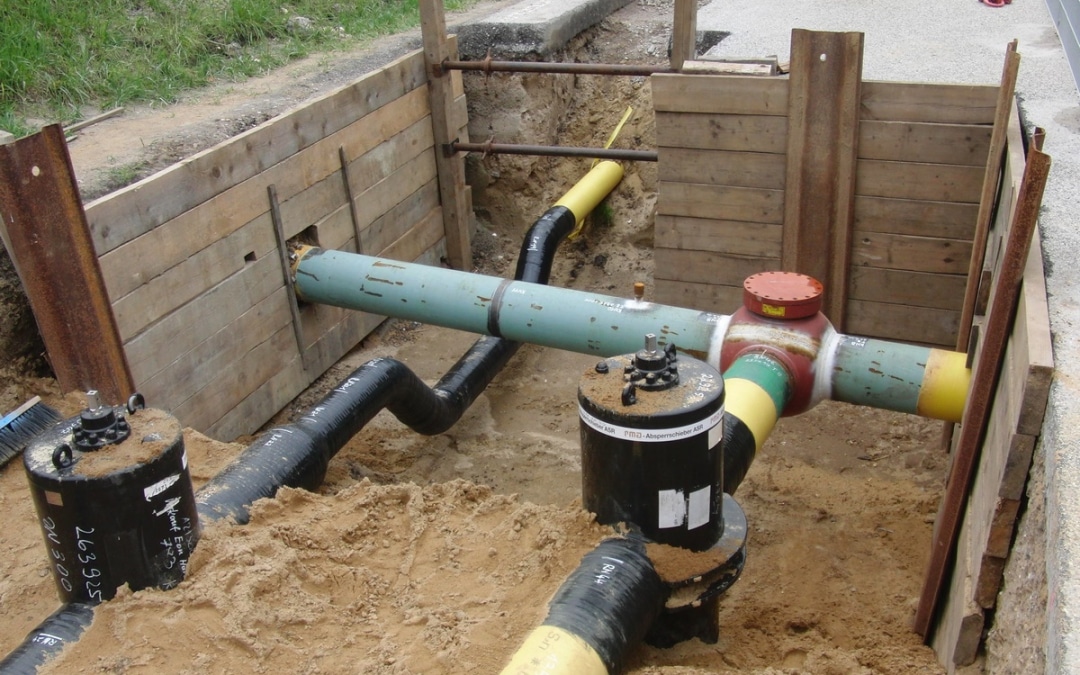
Just switch over?
Hydrogen in the existing natural gas network
Whether hydrogen contributes to the clean heating transition will also depend on how easily existing natural gas networks can be converted. This is what Gasnetz Hamburg wants to find out in the project H2Switch100. For this, the company is looking at a very ordinary section of its existing network.
There’s nothing special about the small grid section in the southern district of Hamburg – exactly why the grid operator Gasnetz Hamburg chose it. In total 16 connections, including 14 normal households, a business park and a sports club. In the residential buildings, natural gas heating systems are installed. The business park and sports club operate a combined heat and power plant with natural gas. There are in the partial network new PE (polyethylene) pipes as well as old steel pipes and house connections from various decades. “The network section is representative for Hamburg’s gas grid,” said Sebastian Esser, project leader at Gasnetz Hamburg.
The aim is to find out whether other ordinary network sections could also be converted to hydrogen. The mix of materials and designs distinguishes H₂-SWITCH100 from the longer-running project H2Direkt of the company Thüga in Hohenwart. There, already in winter 2023/24, ten households and one commercial customer are to be supplied with pure hydrogen. However, only PE pipes, known to be suitable for hydrogen, are installed there (see p. 30).
Feasibility study with laboratory trials
In Hamburg, meanwhile, preliminary investigations are still pending. Together with the partners TÜV Süd and DBI Gas- und Umwelttechnik, Gasnetz Hamburg wants to demonstrate in a feasibility study within twelve months the integrity of the network for hydrogen. In the first step, samples from the original network will be sent to the lab. “For each component type that occurs in the network, we will examine at least one specimen,” said Esser.
In particular, these are individual gate valves and ball valves, but also entire service laterals and pieces of piping. In the laboratories of partner organizations, the components should then demonstrate that they are suitable for employment in a hydrogen network. Is there any embrittlement of the steel parts? Do the pressure regulators work? Are the shut-off devices tight? Answers to these questions are to be provided in the feasibility study running until August and funded by the investment bank IFB Hamburg (Hamburgische Investitions- und Förderbank).
“We’re very confident about the old components and the pipes themselves, as gas with about 50 percent hydrogen content was flowing through the pipes until the 1980s. Some components, however, were added later,” said Esser. The cost for this first project phase, according to Gasnetz Hamburg, lies “in the low six-figure range.”
Replace meter and burner
If the laboratory tests turn out positive, step 2 will follow: the actual conversion of the network. At issue will not be merely feasibility but also costs. Because even if the network is suitable for hydrogen, at the least the burner nozzles and the meters will probably have to be replaced. Lastly, the standard volume of gas must increase by a factor of three to compensate for the lower calorific value of hydrogen compared to natural gas.
“In the pipes themselves, this is no problem. Firstly, the hydrogen has a lower viscosity and therefore flows faster; secondly, we can slightly increase the pressure if necessary; and thirdly, the pipe diameters in the Hamburg gas grid are sufficiently dimensioned to accommodate the higher throughput,” erklärt Esser.
Many manufacturers already have up their sleeves heaters that can be operated with pure hydrogen, for the coming years. “As far as the combined heat and power plants are concerned, manufacturers have already announced their intention to make devices available for testing,” according to Esser. The additional costs incurred as a result of the pilot test will be borne by Gasnetz Hamburg. Thanks to this pledge, the supplier is being met with wide-open customer doors. “Even some neighbors who do not yet have a natural gas connection have now expressed an interest in hydrogen,” Esser recounted.
Hydrogen from planned industrial network
While the pipes and other components are very normal, the location of the network section is very special. It lies almost directly along the route for the already planned hydrogen network for the Hamburg industry with project name HH-WIN. Already in 2024, Gasnetz Hamburg wants to have built large parts of HH-WIN. In year 2027, the company intends to be able to supply the first hydrogen volumes. The confirmation that this will be an IPCEI (Important Project of Common European Interest), which is eligible for a particularly high level of funding, was still pending at the time of going to press.
“Compared to the needs of industry, the hydrogen requirement for the pilot project is minimal,” said Esser. The hydrogen for the industrial network is to come from three sources, which according to current announcements should all stand ready to be put into operation. On the one hand, there is the 100-megawatt electrolyzer that should appear directly in the industrial area at the site of the former coal-fired plant Kohlekraftwerk Moorburg. After some unrest within the project consortium, Hamburger Energiewerke wants to implement the project now together with asset manager Luxcara as majority shareholder. Commissioning is still targeted for 2026.
Secondly, hydrogen is to come to Hamburg via an ammonia terminal that Mabanft and Air Products announced at the start of 2022. By now, the project has undergone a nautical risk analysis, and the companies are in the process of compiling the documents for the approval procedure. As target year for commissioning Mabanaft still named 2026.
And thirdly, there is the European hydrogen core network of the grid operators. Both with the Netherlands and with Wilhelmshaven, Hamburg is connected by existing long-distance lines that are to be converted to hydrogen in the first project phase (see p. 30).
How low-CO2 the production of hydrogen will be in each case is difficult to say, as the regulations as well as the energy production and conversion are massively in motion.
Role of hydrogen in the heating transition unclear
If it turns out that the pipeline network could be easily repurposed, this does not make hydrogen the first choice for Hamburg’s heating transition. After all, in contrast to industry, there are many other options for heating buildings with significantly lower conversion losses. This consideration was once also the basis of the Wasserstoff-Roadmap (hydrogen roadmap), which prioritized – initially still scarce – green hydrogen for sectors that are difficult to decarbonize, including first and foremost industry. The environmental and energy office of Hamburg (BUKEA) also is following this strategy.
The Hanseatic city started collecting data for a heating register much earlier than most other large cities, and intends to present a complete heating plan already by 2024. In the city center, this will probably mainly be district heating, while heat pumps are popular in the peripheral areas.
“Certainly, converting the natural gas pipelines to pure hydrogen operation is not a solution for the whole of Hamburg,” acknowledged Michael Dammann, the technical managing director of Gasnetz Hamburg. “However, the further use of an already existing infrastructure with the green gas can be a sensible supplement to options like expansion of district heating and heat pumps in certain building structures and locations. With H₂-SWITCH100, we want to find out specifically what effort and costs are associated with such a changeover and whether there are technical hurdles.”
Author: Eva Augsten


